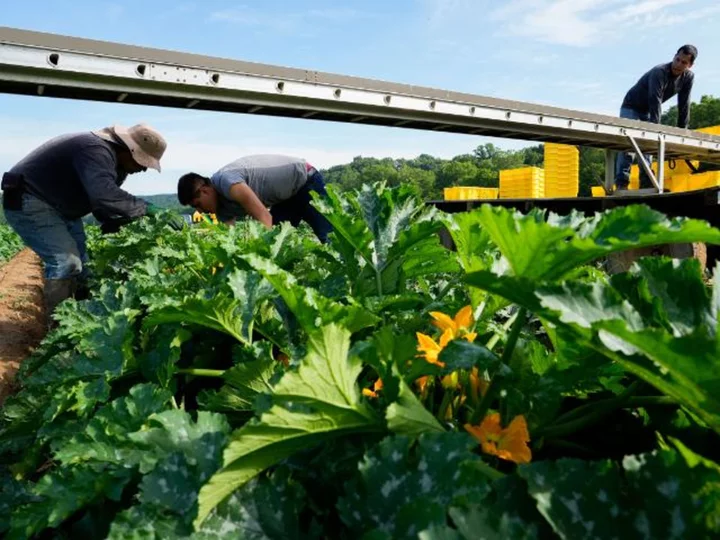Estela Martinez usually dons a light shirt and a thin jacket to protect her body from the scorching sun when she's out in the fields. As a farmworker, she makes a living by spending her days in Florida's punishing heat.
She takes multiple bottles of water with her and uses the slow-moving tractors for shade.
But lately, as extreme temperature records pile up, she said the heat has made her work more unbearable. More than 50 record-high temperatures have been set across Florida since the start of June, and brutal humidity has made the heat even more dangerous, making it more difficult for the body to cool itself.
"The heat has been very strong, and I'm sweating a lot more easily," Martinez told CNN. "I have never felt heat this way after so many years working in the fields."
Every day is a grueling endurance exercise for Martinez, punctuated by sips of water and taking shelter from the blistering sun.
Outdoor workers, particularly those in the farming and construction industries, are just one of the groups for which summer is now a survival test. It's also more deadly for people experiencing homelessness, communities of color, low-income families and the elderly.
Heat kills more Americans than any other weather-related disaster, according to data tracked by the National Weather Service — and climate change is making these extreme events more intense and frequent.
Alerts for dangerous levels of heat have been posted in Texas and Arizona for more than 30 days in a row, and dozens of heat records are set to fall this weekend from the Rio Grande to the Pacific Northwest.
California's Central Valley faces a historic heat wave with temperatures in some locations forecast to exceed 120 degrees.
And in Phoenix, July is off to its hottest start on record: Every day has climbed to 110 degrees Fahrenheit or more so far, and the forecast is looking to remain that way well into next week — potentially the longest stretch of temperatures higher than 110 degrees in the city's history.
More than 400 people died in metro Phoenix last summer from heat-related health conditions, according to a Maricopa County health report, with people experiencing homelessness making up the largest proportion of that death toll. Most of those deaths occurred outdoors.
David Hondula, Phoenix's first chief heat officer, said that's why he's taking a different approach to keep residents — particularly people experiencing homelessness — cool, healthy and safe, as the city continues to face a potentially record-breaking heat wave.
Instead of cooling centers, the city is now calling the facilities "respite centers" to make it clear for people that they are welcome to sleep, rest and find refuge during the scorching weather.
"There's a lot of messaging around checking on friends, family members, neighbors — but I don't think we've seen the messaging enough in past years, and that activity really should happen multiple times per day," Hondula told CNN. "Heat illnesses can come on very quickly."
Kristina Dahl, climate scientist with the Union of Concerned Scientists, said people who work outdoors, like Martinez, have a much higher risk of becoming ill or dying because of extreme heat.
"When it comes to protecting the health of outdoor workers during extreme heat events, there are really just three fundamental pieces — water, shade and rest," Dahl told CNN.
Concerningly, Dahl said, many farmworkers tend to get paid for how much they pick or harvest: "Taking breaks to stay safe in the heat can translate to lost earnings."
"We need to make sure we're protecting their wages so they're not choosing between a paycheck and their health," Dahl added.
Martinez said she's "one of the lucky ones," because her salary doesn't depend on how much she harvests.
"I have the opportunity to take a rest whenever I need them, but this is not the situation for every farmworker."
Most farmworkers live in low-income households, said Pablo Ortiz, senior water and climate scientist at UCS. After spending long, arduous hours out in the sun, they come home and cannot afford the energy to turn on their air conditioners. That poses yet another deadly health risk as nighttime heat gets worse.
"Something that's also happening with climate change is that nighttime temperatures are also rising," Ortiz told CNN. "So, there are many days where the heat doesn't cool off as much, and if there is no air conditioner, then they also don't rest. Then they need to start early again."
Vivek Shandas, a professor of climate adaptation and urban policy at Portland State University, said race is also a strong indicator of who suffers the most from extreme heat. One recent study found low-income neighborhoods and communities with high Black, Hispanic and Asian populations experience significantly more heat than wealthier and predominantly White neighborhoods.
Those results reflect what Shandas has found in his own research: that the legacy of redlining — the racially discriminatory housing practice of the early 20th century — is still apparent today.
Cities must protect their most vulnerable communities, Shandas said, by accelerating the planting of more trees and green spaces, which not only provide shade but prevent temperatures from climbing too high during the day. They should also provide cooling facilities and distribute air conditioning units in a sustainable and affordable way, he said.
Dahl also pointed out that — while green spaces, swimming pools and cooling centers are critical — "we also need to be looking at ensuring access to cooling at home by preventing utilities from shutting off the electricity during heat waves even in cases where someone is behind on their bills."
As global temperatures continue to be shattered, Shandas said solutions need to move quickly.
"It's making me worry about where the world is heading," he said. "We're not adapting fast enough."

